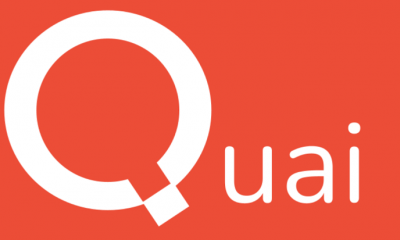FEATURED
What is Quai Network?

Quai is believed to be coined from the Mandarin word ‘Kuai’ which has the literal meaning of “piece” The word is believed to have historically been used to refer to coins made of silver or copper and is the colloquial measure word for money. Today, i will you through the workings of the network and tell you all you need to know.
Mechanism
It is a decentralized modular network of 13 independent blockchains that use Proof-of-Work 2.0 (PoW2) consensus and run as a decentralized modular network. All blockchains on the network fall into one of three categories: prime, region, or zone. In spite of its multi-chain structure, the network enables the blockchain in its network fully interoperable, facilitating both cross-chain transactions and communications.
Proof-of-Work 2.0 (PoW2) implements a mix of merged mining and sharding, which enables miners to secure several blockchains with the same amount of hash power. By using the same amount of hash power to secure multiple asynchronous chains as would be required to protect a single monolithic chain, Quai Network is able to substantially minimize the amount of energy that is required for each transaction when interfacing with PoW blockchains.
It uses PoW2, which they claim is more efficient than the original PoW process since it allows hash power (the combined computational power of a specific cryptocurrency network or the power of an individual mining rig on that network) to be reused to secure many chains. As a smart contract platform, the network also claims that it is the first decentralized cryptocurrency that can scale to accommodate all of the world’s commercial activity.
The Architecture
The network uses sharding to improve network performance by splitting a single blockchain into multiple smaller and faster blockchains. Proof-of-Stake chains like Ethereum, Polkadot, and Near have done most of the work on sharding up to this point. With combined mining, miners may protect many blockchains at once without increasing their power consumption. Unlike Bitcoin, Quai networks can become greenhouse-gas negative while using 10,000 times less energy per transaction. At launch, Quai will start with one Prime chain, three Region chains, and nine Zone chains.
Prime Chains
The Quai Network will initially consist of a single Prime chain, which will use a memory-intensive hashing method that is shared by all inferior (Region and Zone) chains. All miners must mine the Prime chain since it aggregates and settles state changes across the network.
They are less suitable for straightforward transactions and dApp activity due to their higher difficulty and slower throughput (one block every 15 minutes). Since all miners are mining the Prime chain, prime chains are used in circumstances where the entire network is being addressed.
Region Chains
Cyprus, Paxos, and Hydra are the three Region chains that the network will debut with. Compared to the Prime chain, region chains have a higher throughput (one block every five minutes) and lesser difficulty. Since a miner can only mine one Region chain at a time in addition to the Prime chain, unlike for prime chains, no miner is able to mine all Region chains. Despite this, native communication is still possible between all three Region chains.
Zone Chains
A level below Region chains is the Zone chains. Three Zone chains will be nested beneath each Region chain at launch making a total of nine. Miners can only select one Zone chain to mine, just as they can only select one Region chain in addition to the Prime chain. Zone chains are best for routine transactions and contract interactions since they offer the highest throughput—up to one block every 10 seconds. Zone chains can communicate with one another, even if they are part of a different Region chain. As a result, the Zone chain will be where the majority of Quai Network activity takes place.
The typical blockchain needs to strike a balance between security, decentralization, and throughput that is, efficiency in a given time. Quai Network claims to circumvent this ‘blockchain trilemma” with its multi-threaded architecture, which permits scalability. This allows the network to process up to 50,000 transactions per second.
Tokenomics
The Quai token serves as the network’s backbone. Although Quai tokenomics is still under development, the Quai team has released some information about their token plans
The majority of the allocation will go to Adoption Incentives and Mining as 25% and 20% are designated to them. The remaining 65% will be distributed among Partners, Community, Incentives, Bounties, and Contributors, where Strategic Partners and the Foundation will take 15% each while the Founders and Bounties will take 5% each. Infrastructure Partners are included as they will be allocated 5.5%.
Photo Credit: Quai Network
The Community will take up 3% while Contributors will occupy 4%. Exchange liquidity is placed at 2% and Testnet Incentive at 0.5%. These numbers are subject to change by the team as more development unfolds.
Team
Alan Orwick: Co-founder, a computer scientist with two years experience working with Apple, and Research Analyst for Information Service Group
Siriam Vishwanath: Co-founder; Advisor for Azul Mobile and Lynx Laboratories. He’s also the Co-founder, Accordion Health, GenxComm and Privasera. Siriam is a Professor in Electrical and Computer Engineering at The University of Texas
Karl Kreder: Co-founder
Conclusion
Quai Network is looking to tackle major blockchain issues on the mainnet launch. The network adopts a Proof of Work method (PoW 2.0), which will help the environment better than the conventional Proof of Work and would help provide a secure system for its blockchain and allow smooth operation between blockchains in its network, spurring innovative development within the web3 space.
Read also: What is the Internet Computer DEX – ICPSwap?















Pingback: What is Quai Network? by Marvelous Akpere – CryptoTvplus Events: NFT, DeFi, Bitcoin, Ethereum, Altcoin Events
Pingback: What is Quai Network? | CryptoTvplus: DeFi, NFT, Bitcoin, Ethereum Altcoin, Cryptocurrency & Blockchain News, Interviews, Research, Shows - Crypto News Wire